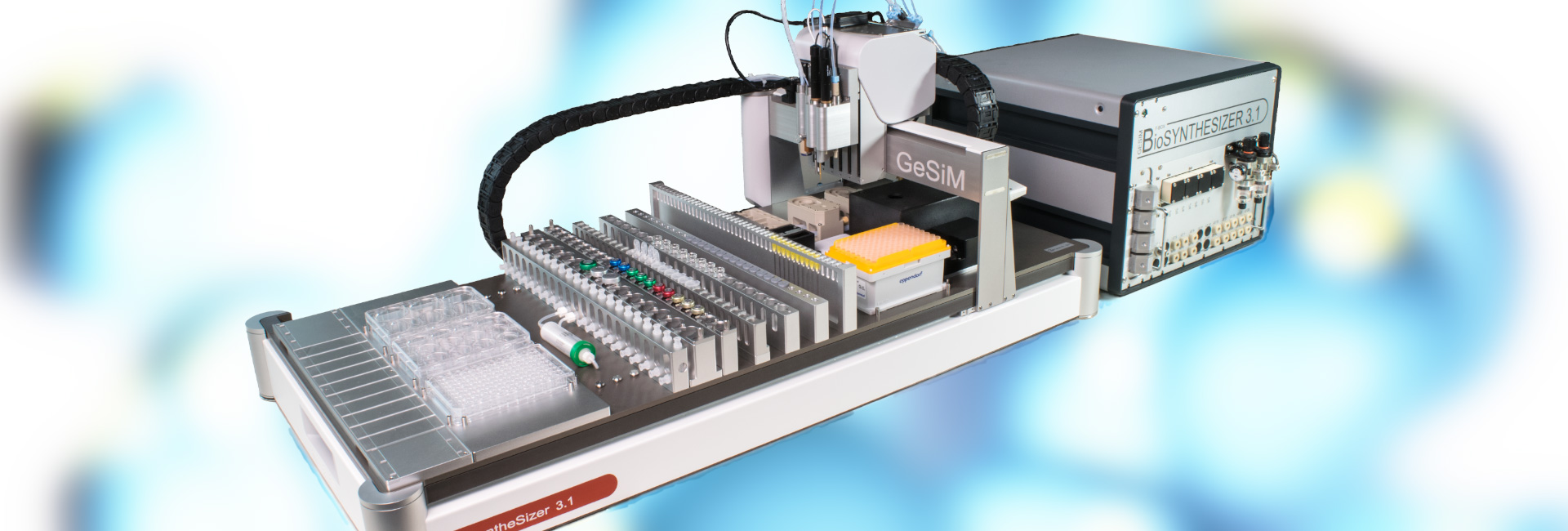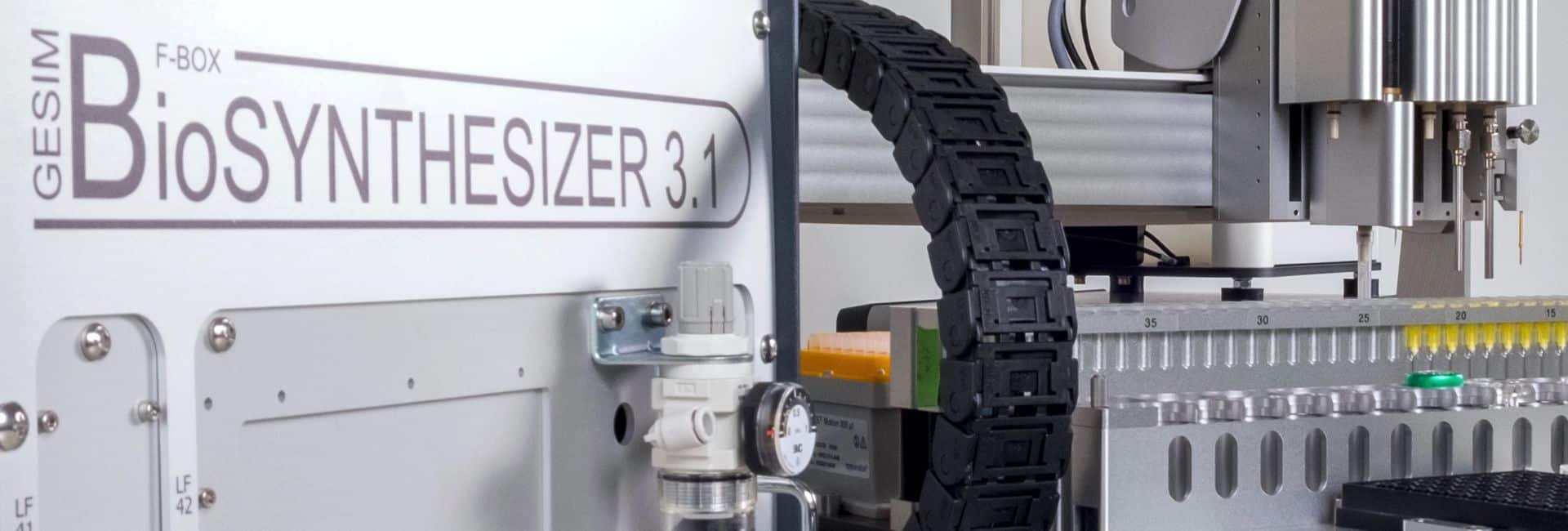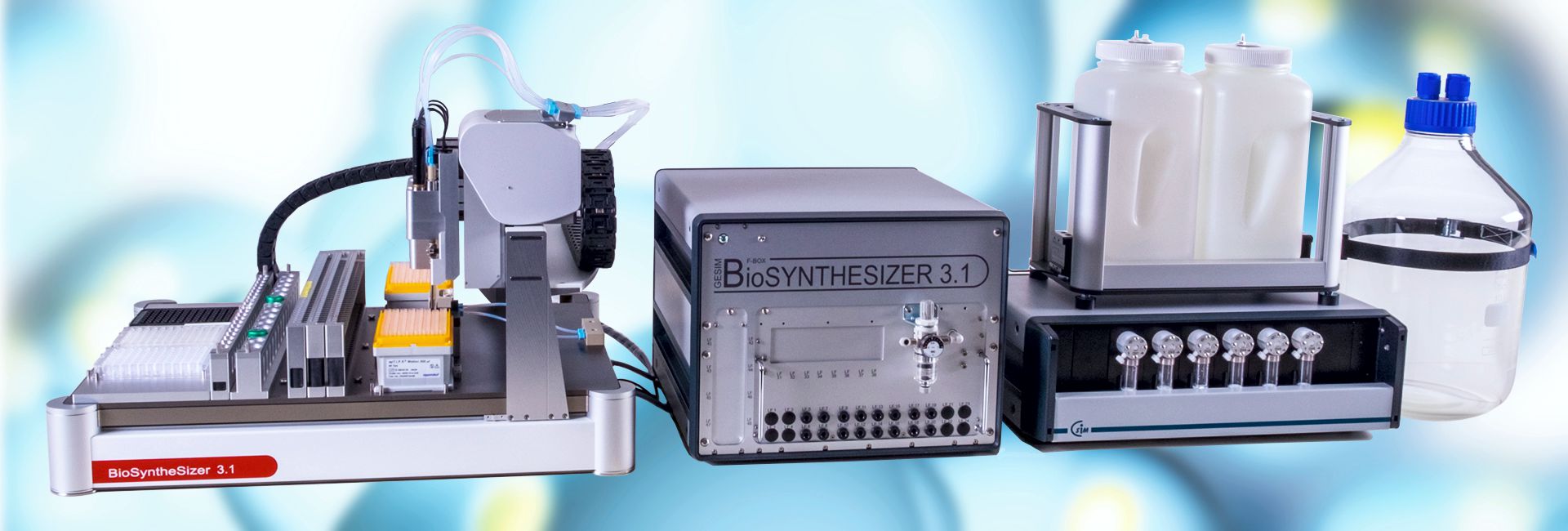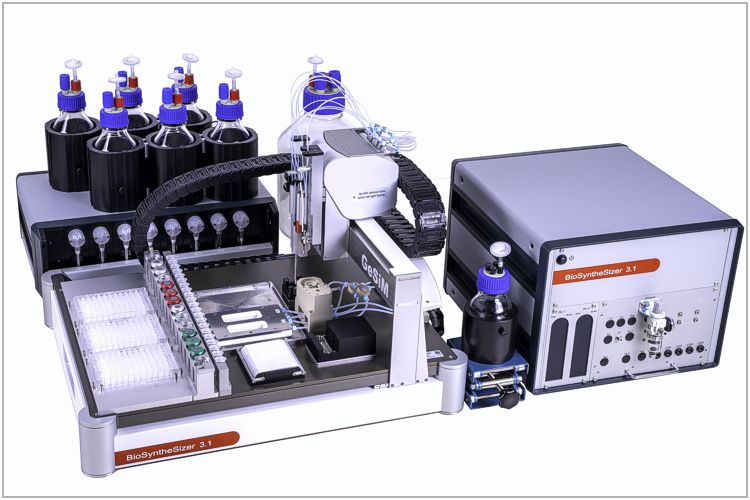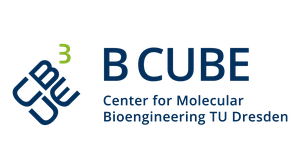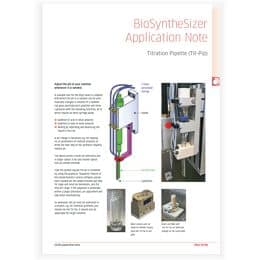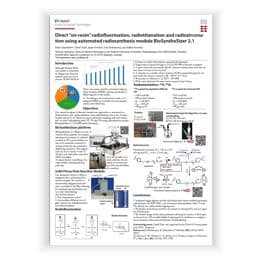BioSyntheSizer – A Liquid Handling Robot and More
Concept of the BioSyntheSizer
The compact liquid handling robot BioSyntheSizer from GeSiM manifests a new instrumentation concept for robots for complex laboratory automation on low-volume scale. It’s a very compact lab automation platform whose goal is utmost flexibility. This liquid handling robot offers all usual tools for automated pipetting: Pick-up and displacement of pipet tips, automatic lid opening/closing, manipulation of vials, tubes and more. On top, it can be extended with the proven GeSiM Picolitre pipetting technology based on piezoelectric micropipettes.
Not to forget: Miniaturized reactor vessels can be added for chemical synthesis, powder pipetting tools, purification columns, cameras… This class of instrument is not available out of the shelf, it is configured to order. The modular approach allows to upgrade tools aftersales, often without service visit from GeSiM.
From Single Steps to a Workflow
The BioSyntheSizer liquid handling robot relies on a gentle but accurate robotic stage with a multiple tool head with up to seven independently moving Z-axes. Reservoirs like racks for tubes and vials snap on the work plate by quick connectors.
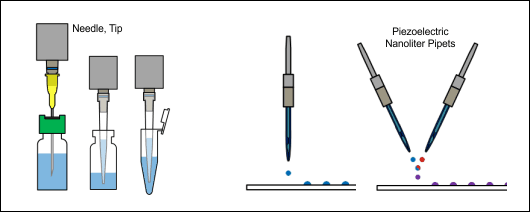
Liquid handling tools: From Picolitre (Right) to Microlitre (Left)
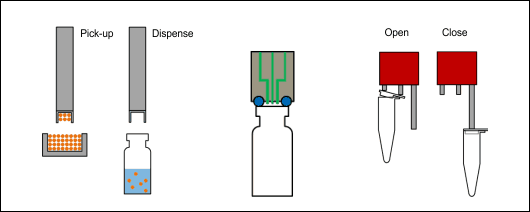
Specials: Powder pipet (Left), 3-Lumen pipet with gripper (Middle), Flip-tube handler (Right)

On the workplate: Column (Left), Bioreactor (Right)
From an application perspective the platform allows to define synthesis work flows consisting of different material handling steps/micro work flows. Very different tools, vessels and reactors connect and work together for a specific application. The instrument software always reflects the current setup and quickly adapts to changing requirements when new hardware gets onboard.
The instrument has been designed for but not limited to the synthesis of biopolymers, e.g. collagen, hydrogels, radiopharmaceutical tracers. See the next tabs for an overview of available tools and example configurations.
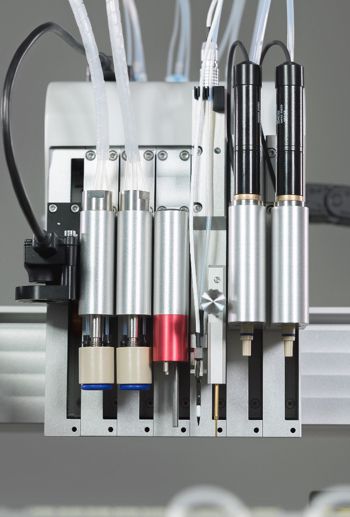
Example of a BSyS print head with seven Z-axes: (1) camera, (2+3) twin tool vaccum gripper + 3-lumen pipet, (4) FlipTube cap opener, (5) heatable piezo pipet +Z-Sensor on one axis, (6+7) nozzle/needle adapter (From left)
Interchangeable Tools for up to 7 Z-Axes
Individually lowering Z-axes allow to synchronize multiple tools with different dimensions. The head of the instrument connects to the F-box (Media control unit for compressed gas, power, vacuum).
Liquid Handling
- Conical receptacle to load/ eject disposable pipet tips and Luer needles
- Needle tips for penetration of antiseptic lids
- Piezoelectric Picolitre pipettes
- Twin-tip Piezoelectric pipet: Two piezo pipets can be swivelled to mix up drops in flight
- Solenoid dispense valves for the Nanolitre range
- Pneumatic/ piezo dispense valves for more viscous drops
Mechanical tools
- Vacuum gripper for crimp vials and 3-lumen pipette for inert gas, solvent, vacuum, e.g. for azeotropic drying of solutes
- Tool for cap opening/closing of FlipTube microcentrifuge tubes
- Z-sensor to measure height profiles of substrates
Others
- Powder pipettes for the Microgram range
- Cartridge dispensers for high viscous media
- Titration pipette for automatic adjustment of pH
- Camera for pattern recognition and QR code identification
- UV lamp for crosslinking
Components for the Work Area of the Instrument
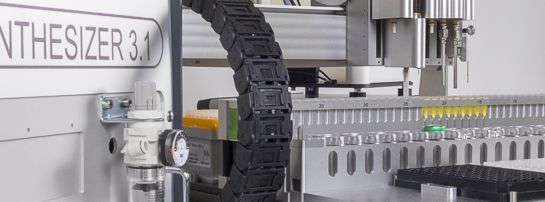
F-Box for media supply (Left), reservoir racks (Right) on BS3.1
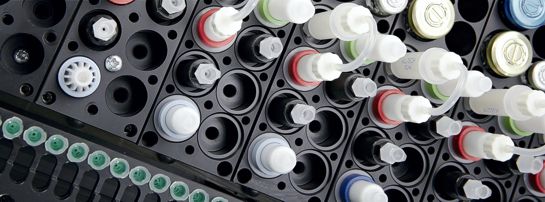
Exchangable racks for standard tubes, vials and needles
On the work deck you find easily mountable and removable holders for disposable pipette tips, needles, microtitre plates, glass slides, storage and reaction vessels (e.g. crimp vials with septum, microcentrifuge tubes with cap) and other freely definable objects that can be heated or cooled on request. A time-controlled connection to extraction or cleaning columns, an HPLC or a photometric analysis can be done via tube adapters.
- Trays for micro well plates/ slides
- Racks for microcentrifuge tubes, septum vials, disposable pipette tips, Luer-lock needles
- Racks with tube adapters to connect nozzles to tubes/columns etc.
- Racks with filter cartridges for ion separation
- Application specific microfluidic manifolds
- Reactors with antiseptic lid, temperature up to 150°C, pressure up to 8 bar
- Magnetic stirrers
- Wash/Dry stations, optical tools for tips alignment and droplet measurement (stroboscope)
- Covers, Chillers and Others
- Enclosure for dust protection, N2 pressure excess
- Humidification
- Chilling and temperature control
- Radioactivity sensors
- Separate F-Box with pumps, valves etc.
The liquid handling robots shown here are all based on one platform; configured for different customer applications by adding different tools and tailored workspaces.
The Promise of Water Containing Hydrogels
Hydrogels are widely used in regenerative medicine. The soft and water containing polymers are well appropriated as cell culture media but keep cells “in shape”: 3D printing arranges the hydrogel in a spatial manner or allows combined printing with other polymers.
In collaboration with the Leibniz Institute for Polymer Research Dresden a BioSyntheSizer configuration for Hydrogel synthesis was developed. The instruments is based on the large platform BSyS 3.1/E. The synthesis starts with the conjugation of Polyethylene Glycol (PEG) with crysteine-containing peptides such that the conjugate contains a terminal thiol group. At the same time, heparin is coupled with reactive groups, all in an automated way.
The PEG-peptide-thiol polymer is then linked to the heparin via a sulphur bridge, and other components (cells, adhesive peptides) are added. Star-hydrogels are possible.
Chemical Synthesis in the Array format
Customers at Technical University of Dresden developed a sophisticated methods to run complex chemical synthesis in the array format, e.g. for peptide synthesis. Peptide arrays synthesized on cellulose membranes are already commercially available. However, high consumption of proteins, as well as light scattering during detection, limit this technology. Glass surfaces are superior, however, fixation of reactants based on aprotic organic solvents (e.g. DMF and DMSO) on the glass surface is challenging (spread of solvents over a large area or vapor mediated undesired motion of droplets).
The researchers in Dresden run a GeSiM BioSyntheSizer liquid handling robot. The instrument is capable of microarraying featuring piezoelectric tips with drop volumes below half a Nanolitre. Further, needle pipetting incl. vial penetration and aspiration from 96well plates allow more complex chemical reactions. The instrument adopts a user-made flow-cell, accommodating two glass slides. Rinsing and drying of the slide surfaces – synchronized with the array spotting algorithm – allow “switchable” surfaces, optimized for subsequent chemical reactions and later bioscreening. Besides peptide chemistry, multicomponent chemical reactions also can be performed on the surface.
GeSiM BioSyntheSizer with wash tray for slides (middle), well plates for amino acids (left) and syringe unit with reservoir bottles (top). A so called “F-box” (right) comprises control computer, pressure regulation and others.
Controlling Surface Wettability for Automated In Situ Array Synthesis and Direct Bioscreening, Weilin Lin et.al., ADVANCED BIOMATERIALS, Published 26th July 2021
Sol-Gel Conversion of a Hydrogel for 3D Bioprinting
The group of S.N. Nazhat at McGill University, Montréal, has found that dissolved collagen fibres can be aligned using an aspiration-dispensing cycle through fine needles, thus creating a gel suitable for additive manufacturing, i.e. 3D bioprinting of collagen hydrogel ‘bricks’. For this project, GeSiM has designed a customized BioSyntheSizer with seven Z-drives that can handle disposable tips as well as steel needles with different gauge sizes.
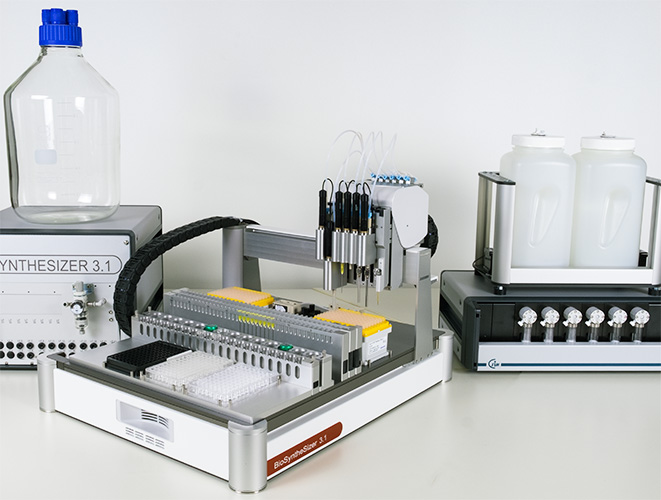
Rapid Biofabrication of Printable Dense Collagen Bioinks of Tunable Properties, Gabriele Griffanti, Ehsan Rezabeigi, Jingjing Li, Monzur Murshed, Showan N. Nazhat, Advanced Functional Materials, Nov. 2019

